Experimental Investigation on Composite Deck Slab Made of Cold-Formed Profiled Steel Sheeting
Abstract
:1. Introduction
2. Literature Review
3. Preliminary Investigation
3.1. Concrete Properties
3.2. Profiled Steel Sheeting Properties
Geometric Variation of Profiles of Steel Sheeting
3.3. Shear Connector
3.4. Mild Steel Bars
4. Experimental Studies on Composite Slab
4.1. Preparation of Composite Slab Specimens
4.2. Experimental Set Up for Flexural Strength Test of Composite Slab Specimens
5. Results and Discussions
5.1. Ultimate Load Carrying Capacity
5.2. Deflection
5.3. End Slip
5.4. Modes of Failure
5.5. Strain Energy
5.6. Ductility Ratio
6. Conclusions
- The behavior of the shear connector composite deck slabs largely depends on the ratio of opening width at the rib to opening width at the top flange (br/bf).
- The dovetailed composite deck slabs’ load carrying capacities are 5.35% and 22.03% greater than rectangular and trapezoidal profiled composite slabs, respectively.
- Deflection and slips of dovetailed, or re-entrant, profiled slabs are lower compared to rectangular and trapezoidal profiled slabs.
- Dovetailed, or re-entrant, profiled slabs showed high resistance to vertical separation.
- The trapezoidal profiled composite slabs attained the maximum strain energy of 2.98 kNm.
- The strain energy stored by the material is lower for the dovetailed profiled composite slabs when compared to rectangular and trapezoidal profiled composite slabs.
- Increasing the ratio of opening width of ribs to flange width increases the ductility ratio.
- The ductility ratio for trapezoidal profile is 36.3% and 55% higher when compared to rectangular and dovetailed profiled composite slabs, respectively.
- Trapezoidal profiled slabs failed by shear bond mode which is the predominant failure in composite slabs which should be minimized.
- The slip at early stages was negligible for all the specimens. In the plastic stage, the magnitude of slip increased significantly with loading.
- The elastic and plastic behavior of the specimen mainly depends on shear span and loading. Short shear span is recommended, if the investigation is focused of the elastic behavior and long shear span for plastic behavior.
- For all the composite deck slabs failing in flexure, the ductility ratio can be defined as the ratio of curvature at ultimate to yield moment capacity.
- Ductility characterizes, after yielding, of the deformation capacity of trapezoidal composite deck slabs was higher than its energy dissipation ability when compared to other composite deck slabs.
- The embossments shown in flange will insightful increase the shear resistance of the composite deck systems.
- The different types, depth and orientations of embossments can be further investigated.
- The bond strength of the composite deck systems can be investigated with chemical adhesives.
- Numerical and analytical investigation for such composite systems with embossments and chemical adhesives are insufficient. Such investigations can possibly develop a new empirical formula for composite deck systems.
Author Contributions
Funding
Institutional Review Board Statement
Informed Consent Statement
Data Availability Statement
Acknowledgments
Conflicts of Interest
References
- Burnet, M.J.; Oehlers, D.J. Rib shear connectors in composite profiled slabs. J. Constr. Steel Res. 2001, 57, 1267–1287. [Google Scholar] [CrossRef]
- Akhand, A.M.; Wan Badaruzzaman, W.H.; Wright, H.D. Combined flexure and web crippling strength of a low-ductility high strength steel decking: Experiment and a finite element model. Thin-Walled Struct. 2004, 42, 1067–1082. [Google Scholar] [CrossRef]
- Kim, H.; Jeong, Y. Ultimate strength of a steel concrete composite bridge deck slab with profiled sheeting. Eng. Struct. 2010, 32, 534–546. [Google Scholar] [CrossRef]
- Wright, H.D.; Evans, H.R.; Harding, P.W. The Use of Profiled Steel Sheeting in Floor Construction. J. Constr. Steel Res. 1987, 7, 279–295. [Google Scholar] [CrossRef]
- Baskar, R.; Antony Jeyasehar, C. Experimental and Numerical Studies on Composite Deck Slabs. Int. Eng. Res. Dev. 2012, 3, 22–32. [Google Scholar]
- Mohammed, B.S.; Al-Ganad, M.A.; Abdullahi, M. Analytical and experimental studies on composite slabs utilising palm oil clinker concrete. Constr. Build. Mater. 2011, 25, 3550–3560. [Google Scholar] [CrossRef]
- Prajapati, K.K.; Vanza, M.G.; Vakil, M.D. Behavior of Cold-formed Stainless Steel Composite Deck. Int. J. Earth Sci. Eng. 2011, 4, 616–618. [Google Scholar]
- Chen, S.; Shi, X. Shear bond mechanism of composite slabs—A universal FE approach. J. Constr. Steel Res. 2011, 67, 1475–1484. [Google Scholar] [CrossRef]
- Abdullah, R.; Samuel, W.E. New evaluation and modeling procedure for horizontal shear bond in composite slabs. J. Constr. Steel Res. 2009, 65, 891–899. [Google Scholar]
- Chen, S. Load carrying capacity of composite slabs with various end constraints. J. Constr. Steel Res. 2003, 59, 385–403. [Google Scholar] [CrossRef]
- Eldib, M.E.; Maaly, H.M.; Beshay, A.W.; Tolba, M.T. Modelling and analysis of two-way composite slabs. J. Constr. Steel Res. 2009, 65, 1236–1248. [Google Scholar] [CrossRef]
- Hedaoo, N.A.; Gupta, L.M.; Ronghe, G.N. Design of composite slabs with profiled steel decking: A comparison between experimental and analytical studies. Int. J. Adv. Struct. Eng. 2012, 4, 1. [Google Scholar]
- Marimuthu, V.; Seetharaman, S.; Arul Jayachandran, S.; Chellappan, A.; Bandyopadhyay, T.K.; Dutta, D. Experimental studies on composite deck slabs to determine the shear-bond characteristic (m–k) values of the embossed profiled sheet. J. Constr. Steel Res. 2007, 63, 791–803. [Google Scholar] [CrossRef]
- Design of Composite Steel and Concrete Structures—General Rules and Rules for Buildings; EN 1994: Part 1; European Committee for Standardization, 2003; Available online: http://www.phd.eng.br/wp-content/uploads/2015/12/en.1992.1.1.2004.pdf (accessed on 9 September 2020).
- Structural Use of Steelwork in Building—Code of Practice for Design of Composite slabs with Profiled Steel Sheeting; BS 5950: Part 4; British Standards Institution (BSI): London, UK, 1994; Available online: https://www.ihsti.com/CIS/document/83107 (accessed on 9 September 2020).
- Baskar, R. Experimental and numerical studies on composite deck slabs. Int. J. Eng. Technol. 2012, 2, 1116–1125. [Google Scholar]
- Lakshmikandhan, K.N.; Sivakumar, P.; Ravichandran, R.; Arul Jayachandran, S. Investigations on efficiently steel concrete composite deck slab. J. Struct. 2013, 10, 628759. [Google Scholar]
- Indian Standard Committee. Specifications for Coarse and Fine Aggregates from Natural Sources for Concrete; IS 383; Bureau of Indian Standards: New Delhi, India, 1970. [Google Scholar]
- Indian Standard Committee. Indian Standard Code of Methods of Sampling and Analysis of Concrete; IS 1199; Bureau of Indian Standards: New Delhi, India, 1959. [Google Scholar]
- Indian Standard Committee. Indian Standard Code of Plain and Reinforced Concrete Code of Practice; IS 456; Bureau of Indian Standards: New Delhi, India, 2000. [Google Scholar]
- Indian Standard Committee. Indian Standard Code of Recommended Guidelines for Concrete Mix Design; IS 10262; Bureau of Indian Standards: New Delhi, India, 2009. [Google Scholar]
- Han, L.H.; Zhao, X.L.; Tao, Z. Tests and Mechanics Model for Concrete-filled SHS Stub Columns, Columns and Beam-Columns. Steel Compos. Struct. 2001, 1, 51–74. [Google Scholar]
- Siva, A.; Senthil, R.; Saddam, M.A. Experimental investigation on longitudinal shear behaviour of steel concrete composite deck slab. J. Struct. Eng. 2016, 43, 445–453. [Google Scholar]
- Siva, A.; Swaminathan, S.; Prasanth, K.; Senthi, R. Experimental Investigation of Trapezoidal Profile Sheeting Under Varying Shear Spans. Appl. Mech. Mater. 2016, 845, 148–153. [Google Scholar] [CrossRef]
- Sheet, I.S.; Ahmed, S.M.; Avudaiappan, S.; Flores, E.I.S.; Chandra, Y.; Astroz, R. Shear bond behaviour of elemental composite beams with different configurations. Eng. Struct. 2019, 201, 109742. [Google Scholar] [CrossRef]
- Ahmed, S.M.; Avudaiappan, S.; Sheet, I.S.; Flores, E.I.S.; Pina, J.C.; Yanez, S.J.; Guzmán, C.F. Prediction of longitudinal shear resistance of steel-concrete composite slabs. Eng. Struct. 2019, 193, 295–300. [Google Scholar]
- Murray, N.W. Introduction to the Theory of Thin-Walled Structures; Clarendon Press: Oxford, UK, 1986. [Google Scholar]
- Zhao, X.L.; Hancock, G.J. Tests to determine plate slenderness limits for cold-formed rectangular hollow sections of grade C450. Steel Construction. Aust. Inst. Steel Constr. 1991, 25, 2–16. [Google Scholar]
- Ge, H.B.; Usami, T. Cyclic tests of concrete filled steel box columns. J. Struct. Eng. ASCE 1996, 122, 1169–1177. [Google Scholar]
- Tao, Z.; Han, L.H.; Zhao, X.L. Behaviour of square concrete filled steel tubes subjected to axial compression. In Proceedings of the Fifth International Conference on Structural Engineering for Young Experts, Shenyang, China, 1998; pp. 61–67. [Google Scholar]
- Siva, A.; Senthil, R.; Swaminathan, S. Assessment of longitudinal shear strength of composite deck slab. Int. J. Innov. Sci. Res. 2016, 24, 277–284. [Google Scholar]
- Siva, A.; Thamilselvi, P.; Saddam, M.A.; Senthil, R. Concrete composite slab construction: State of the art. Int. J. Res. Eng. Technol. 2017, 6, 120–128. [Google Scholar]
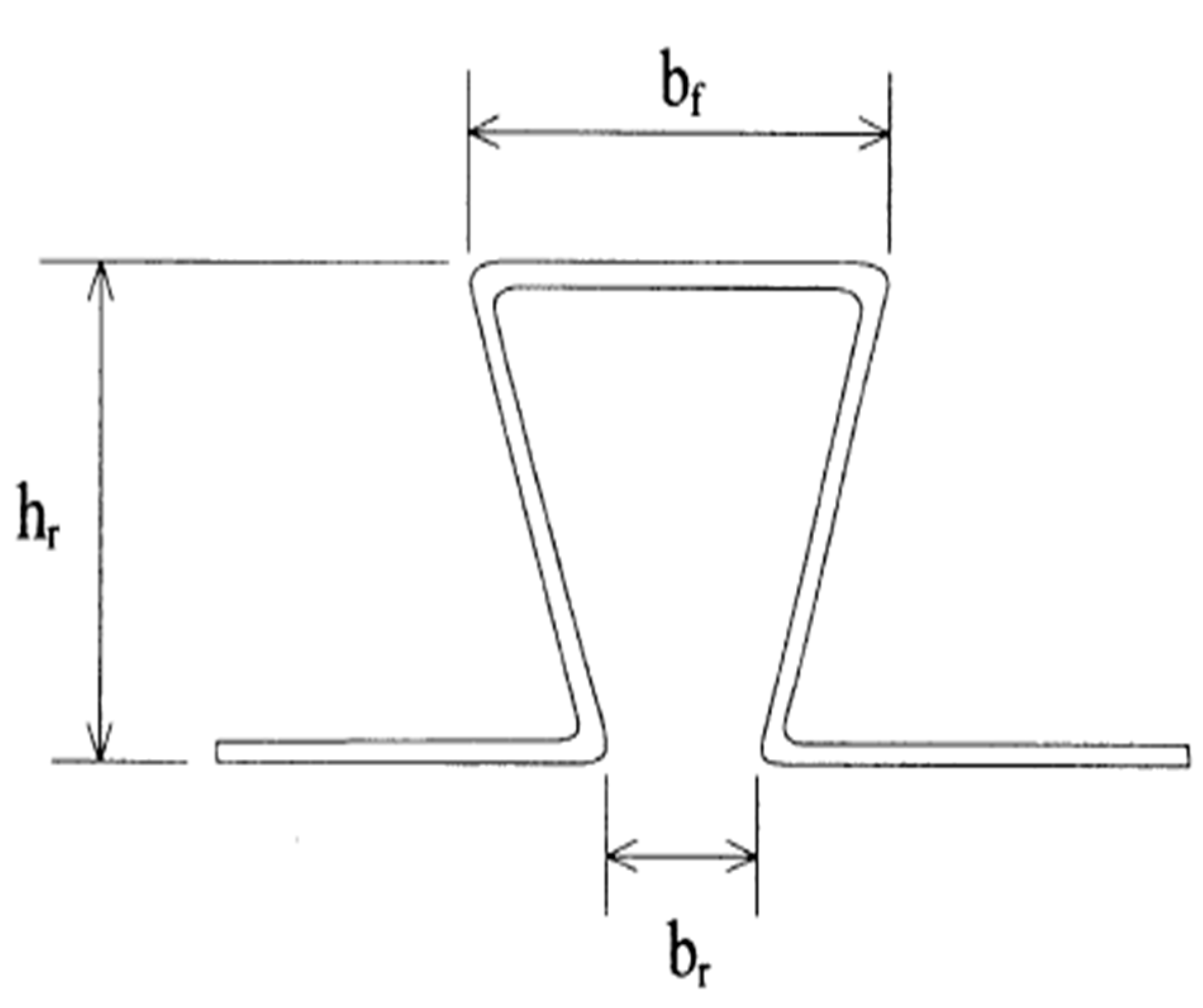
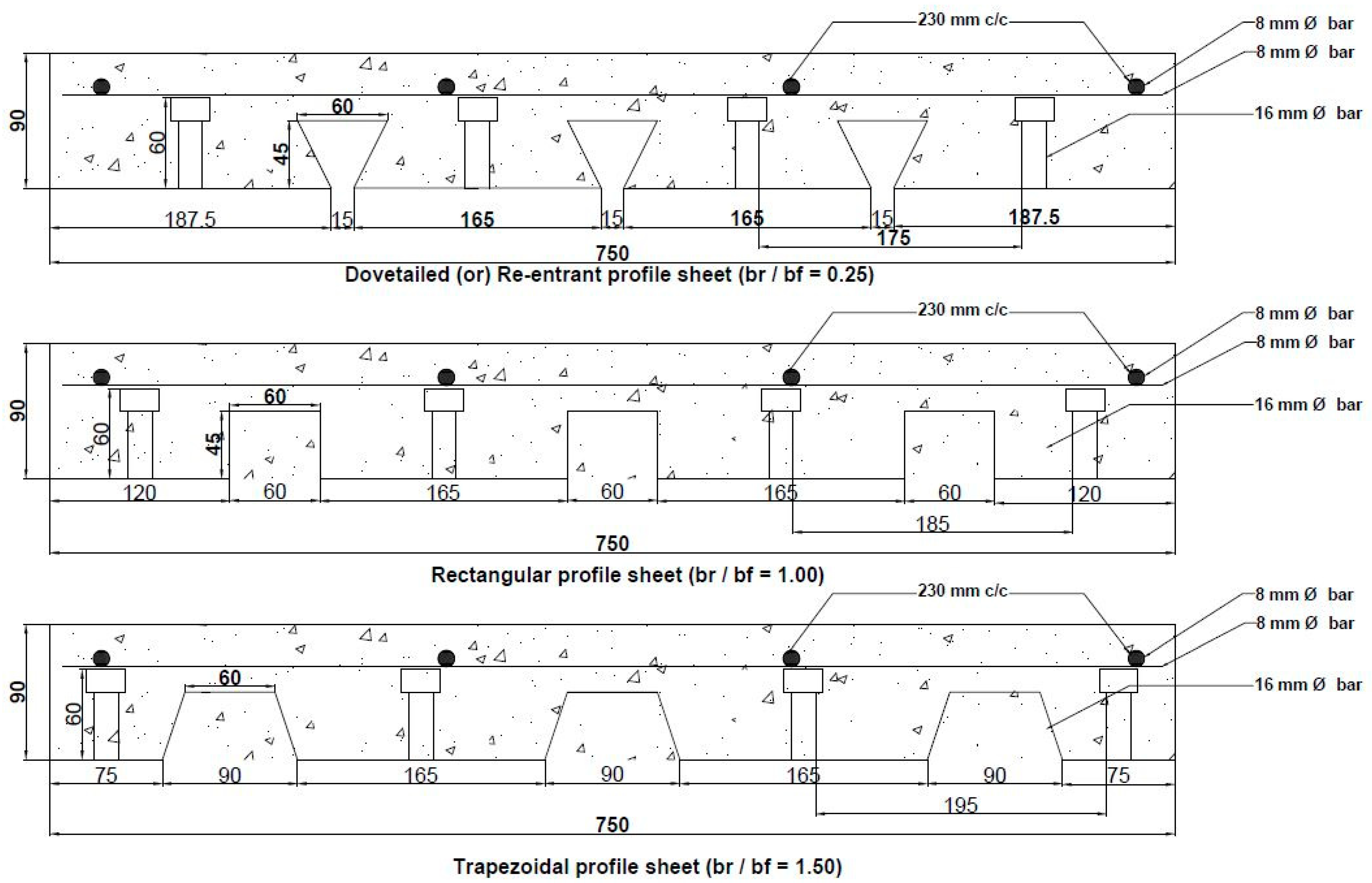
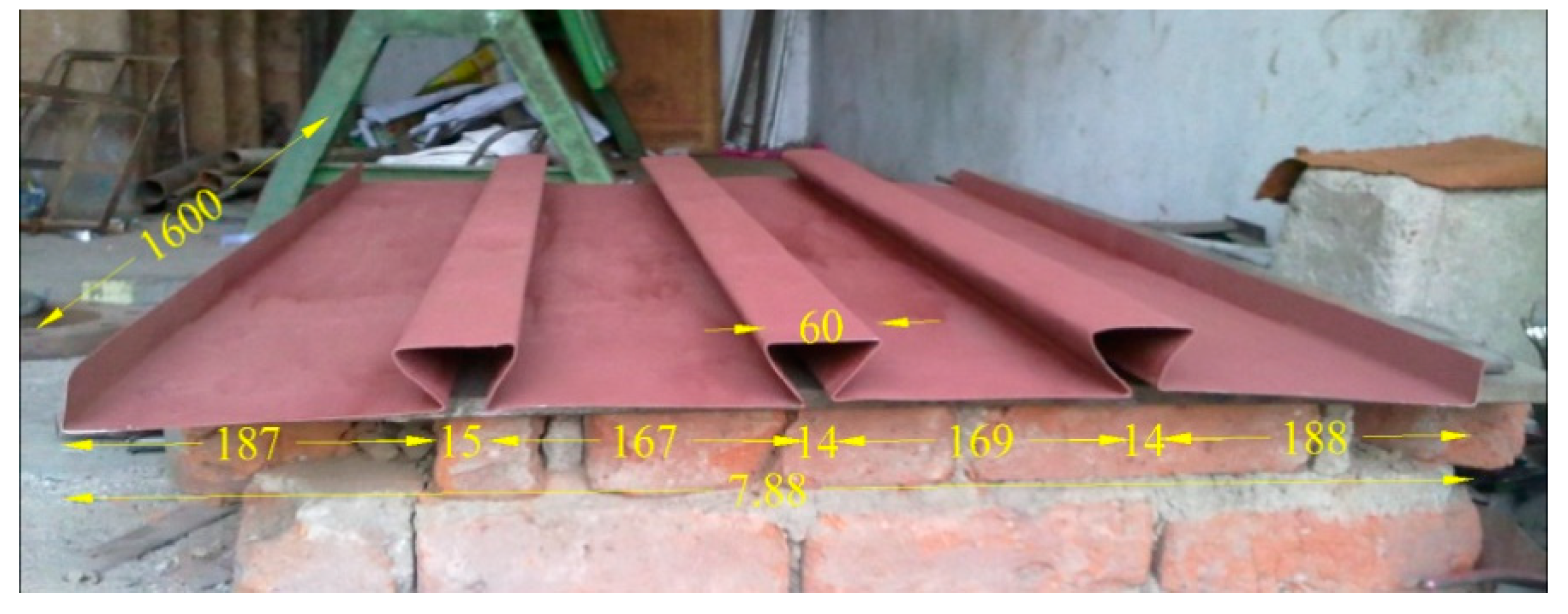
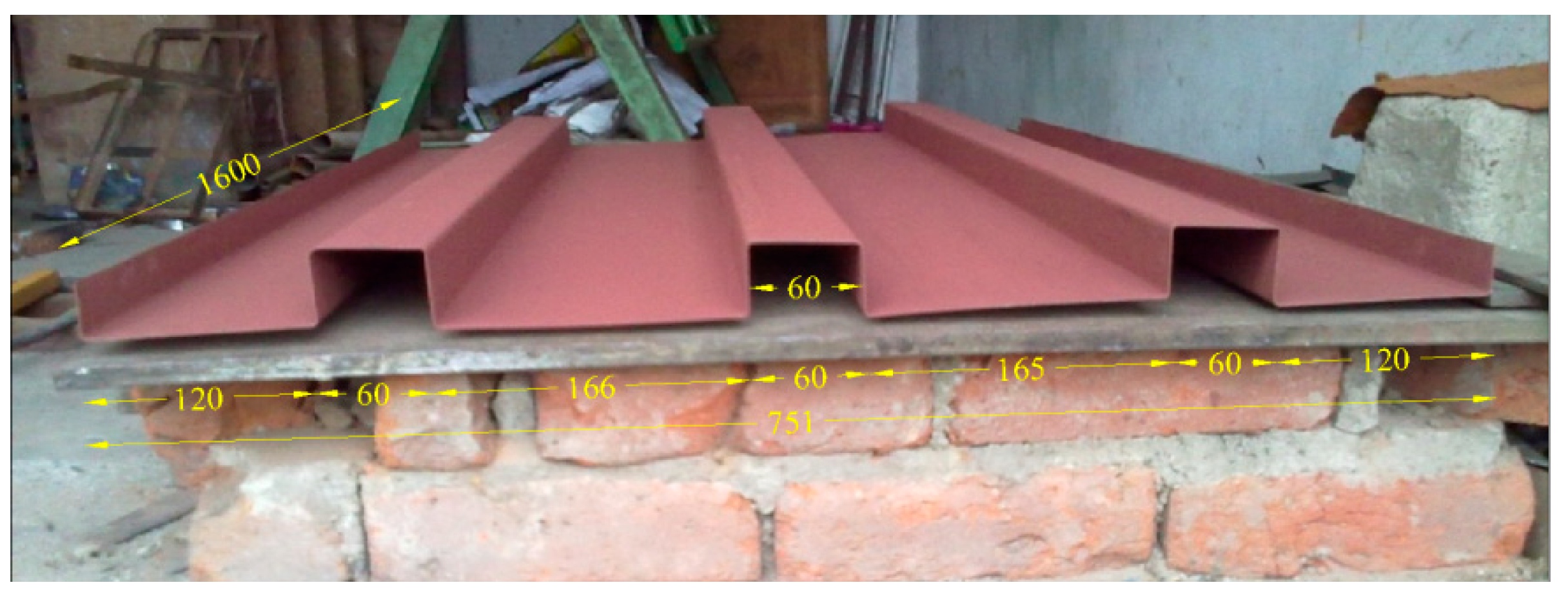
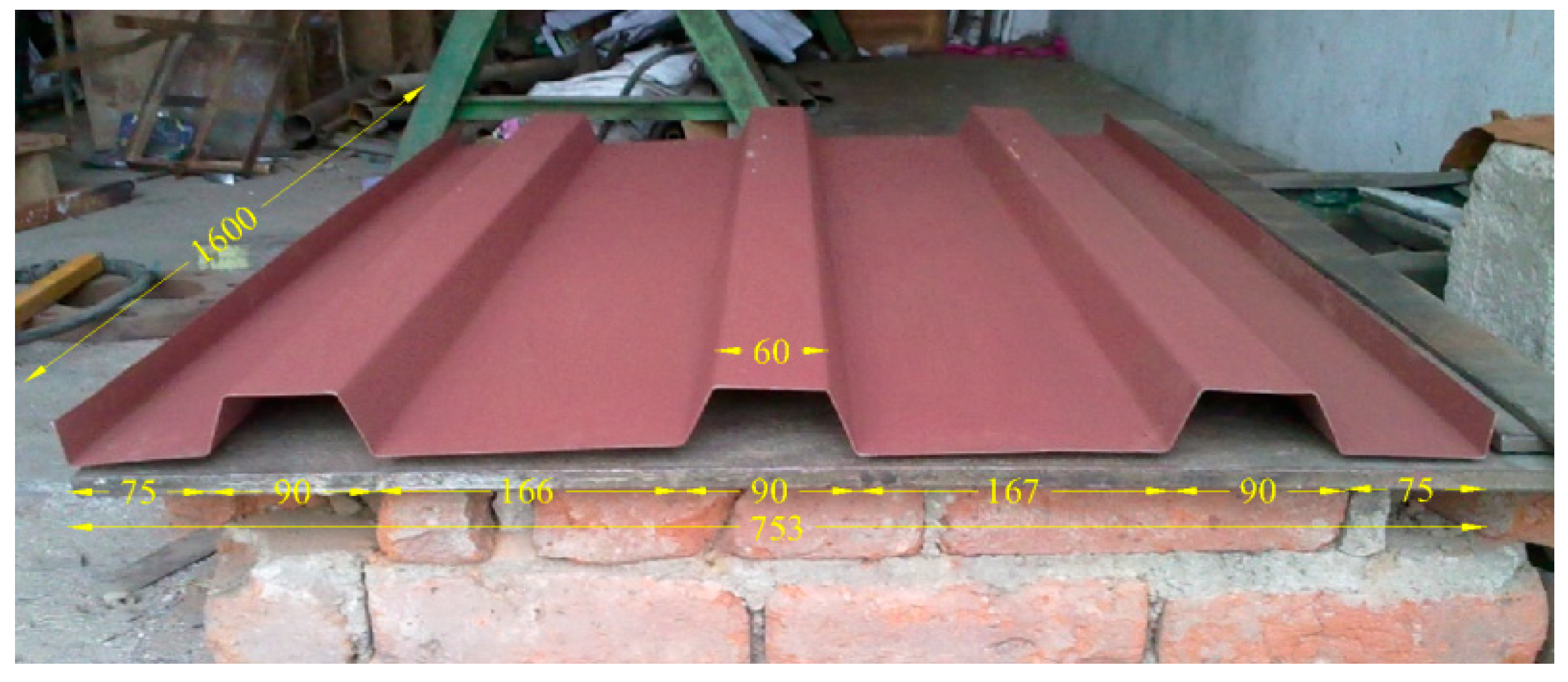
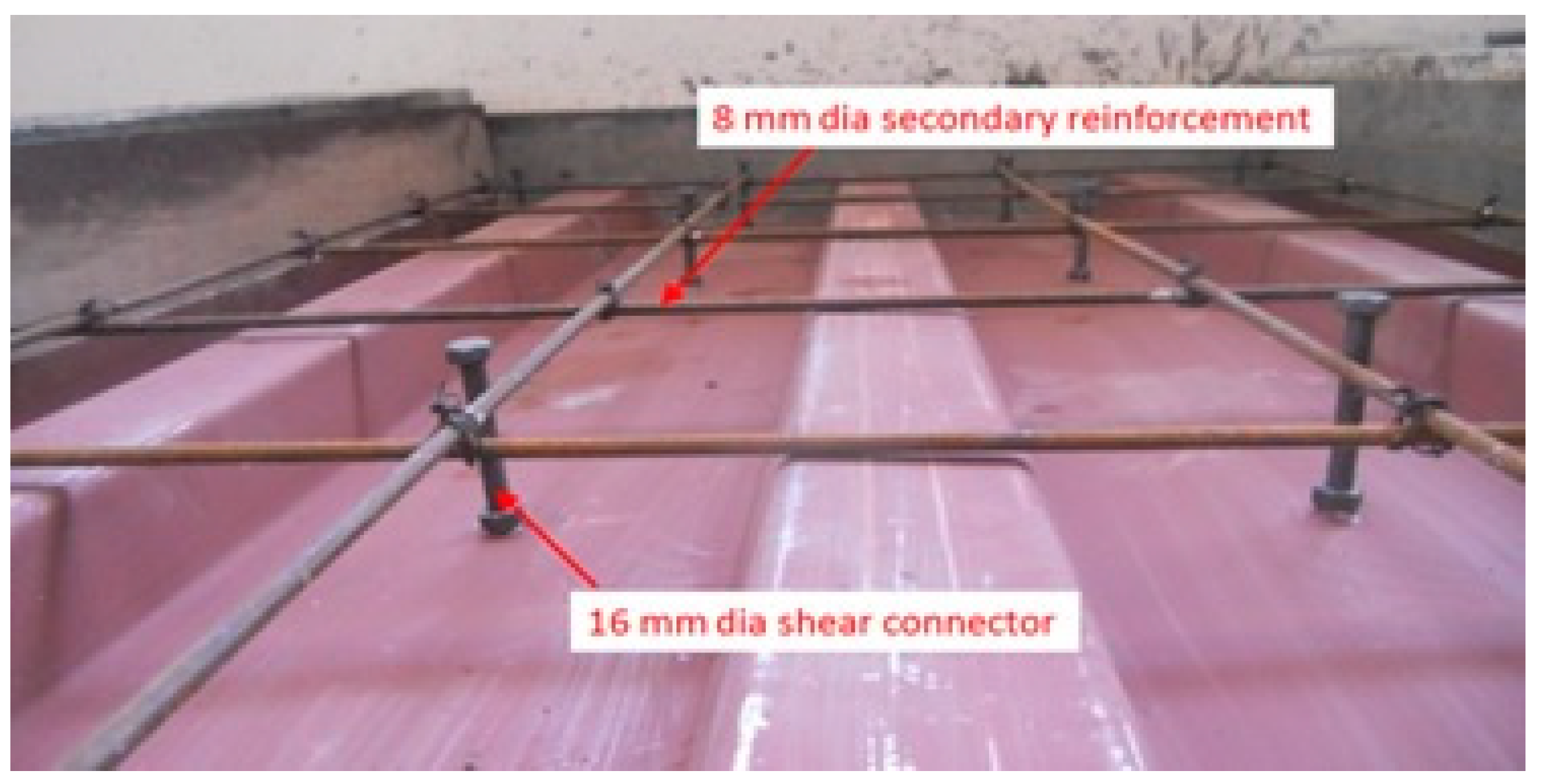

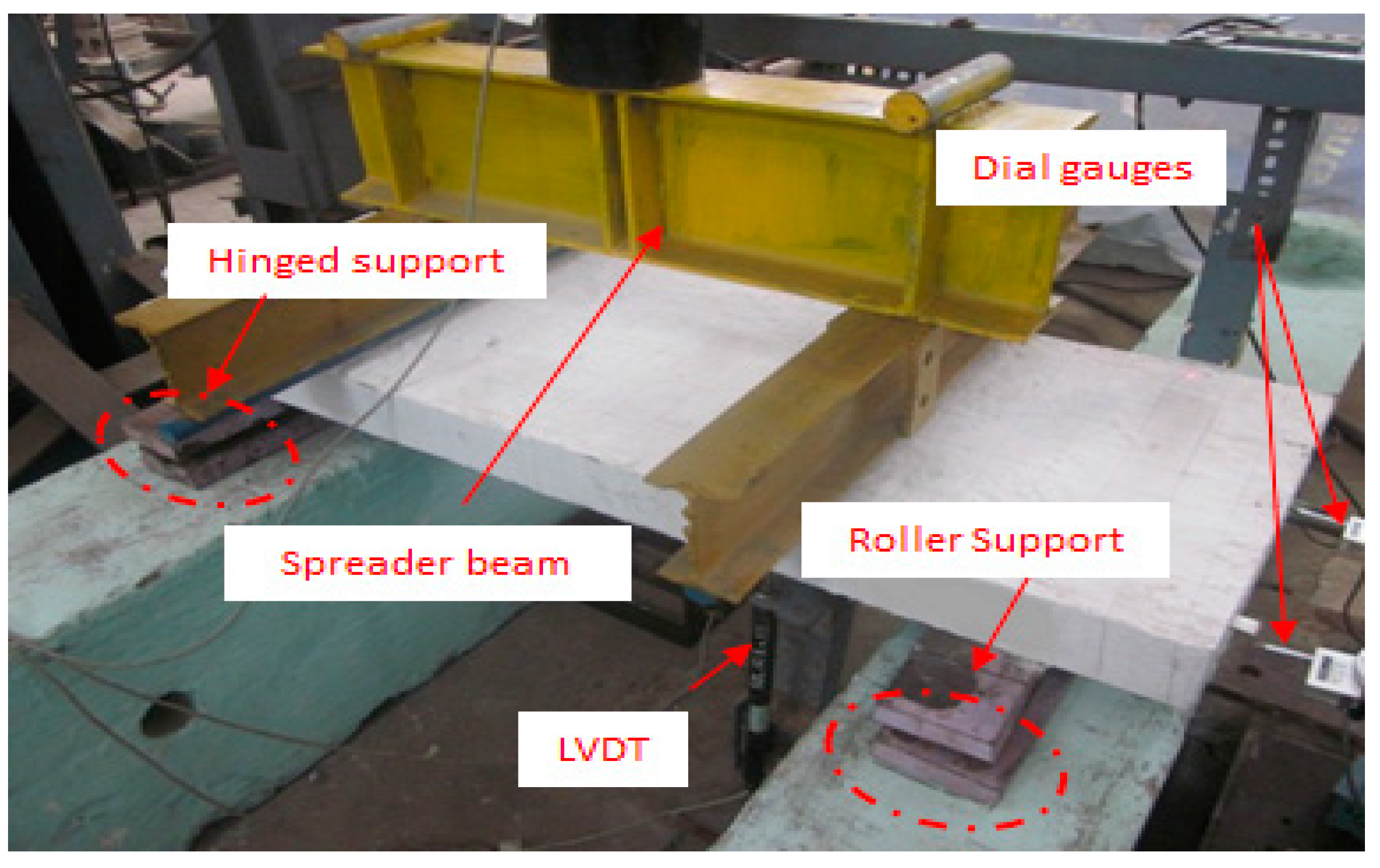
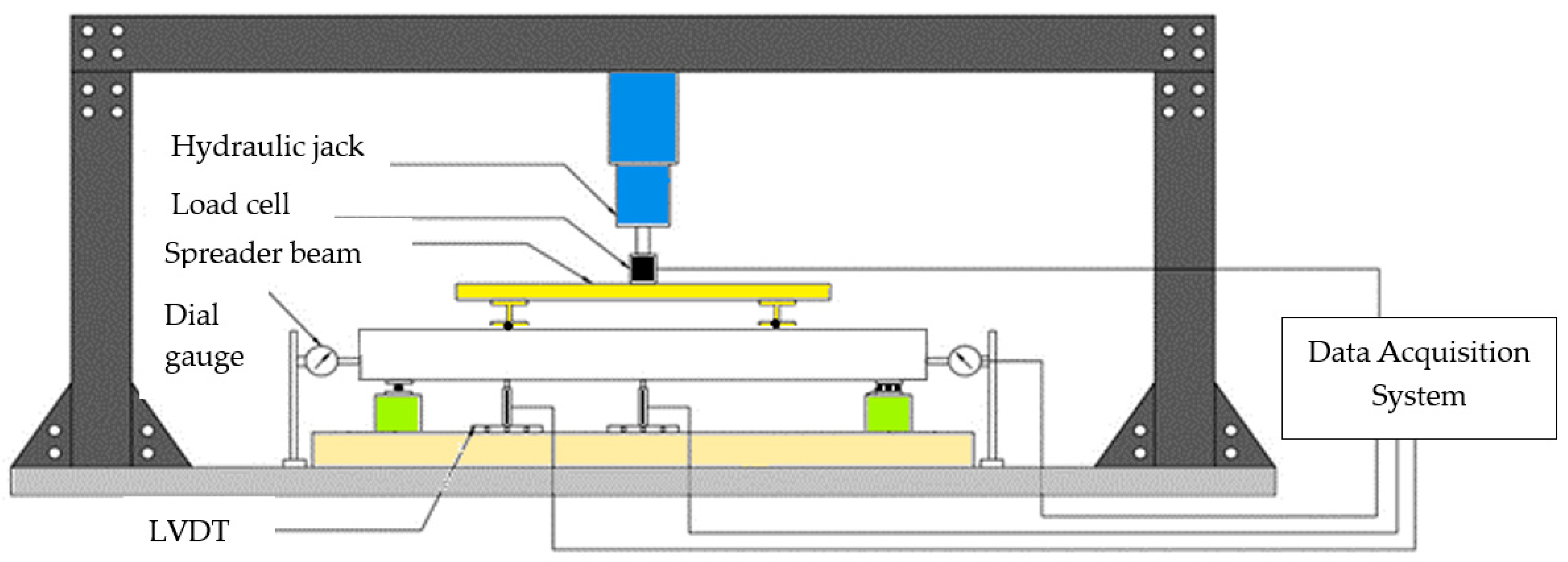
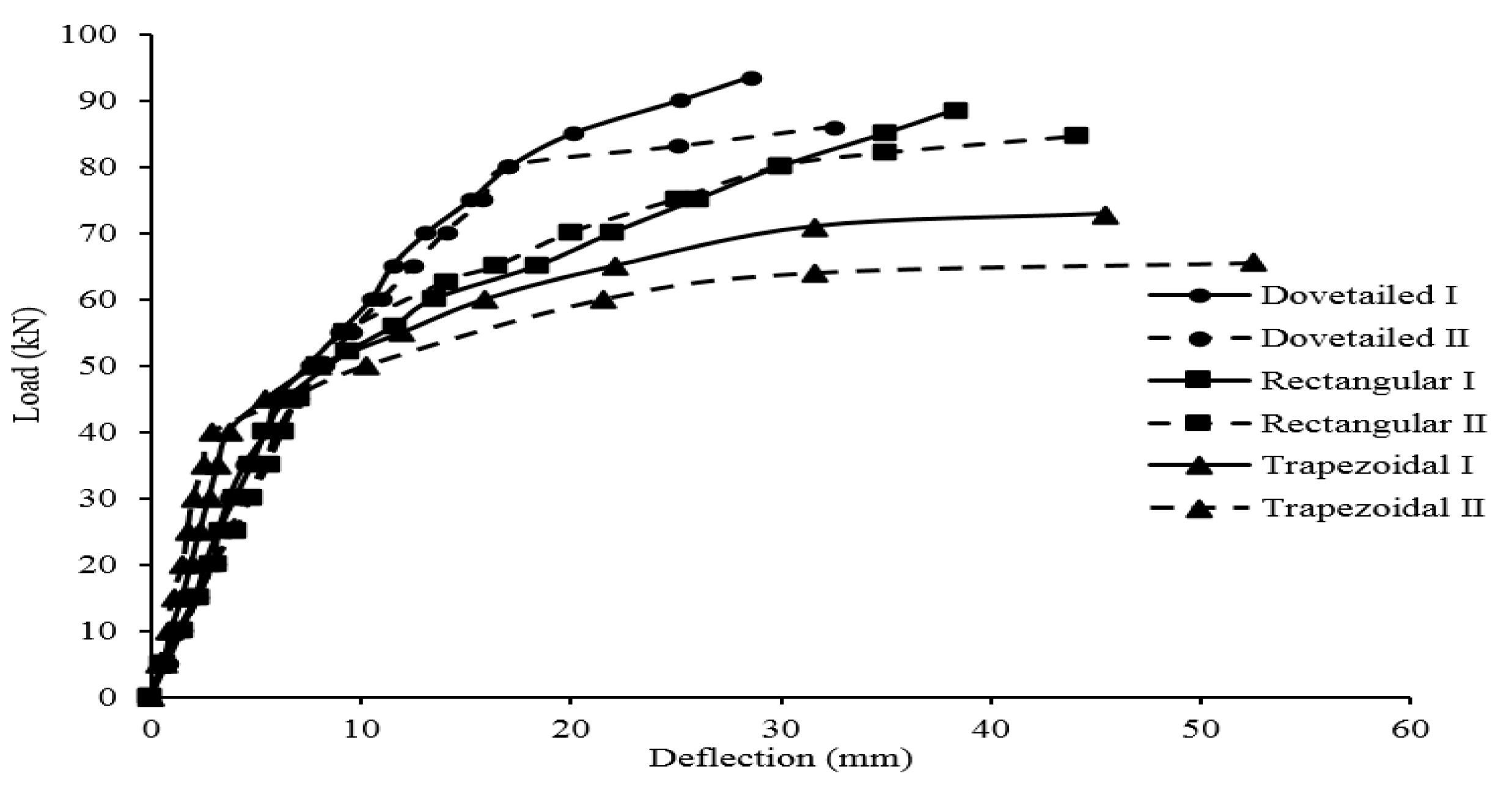
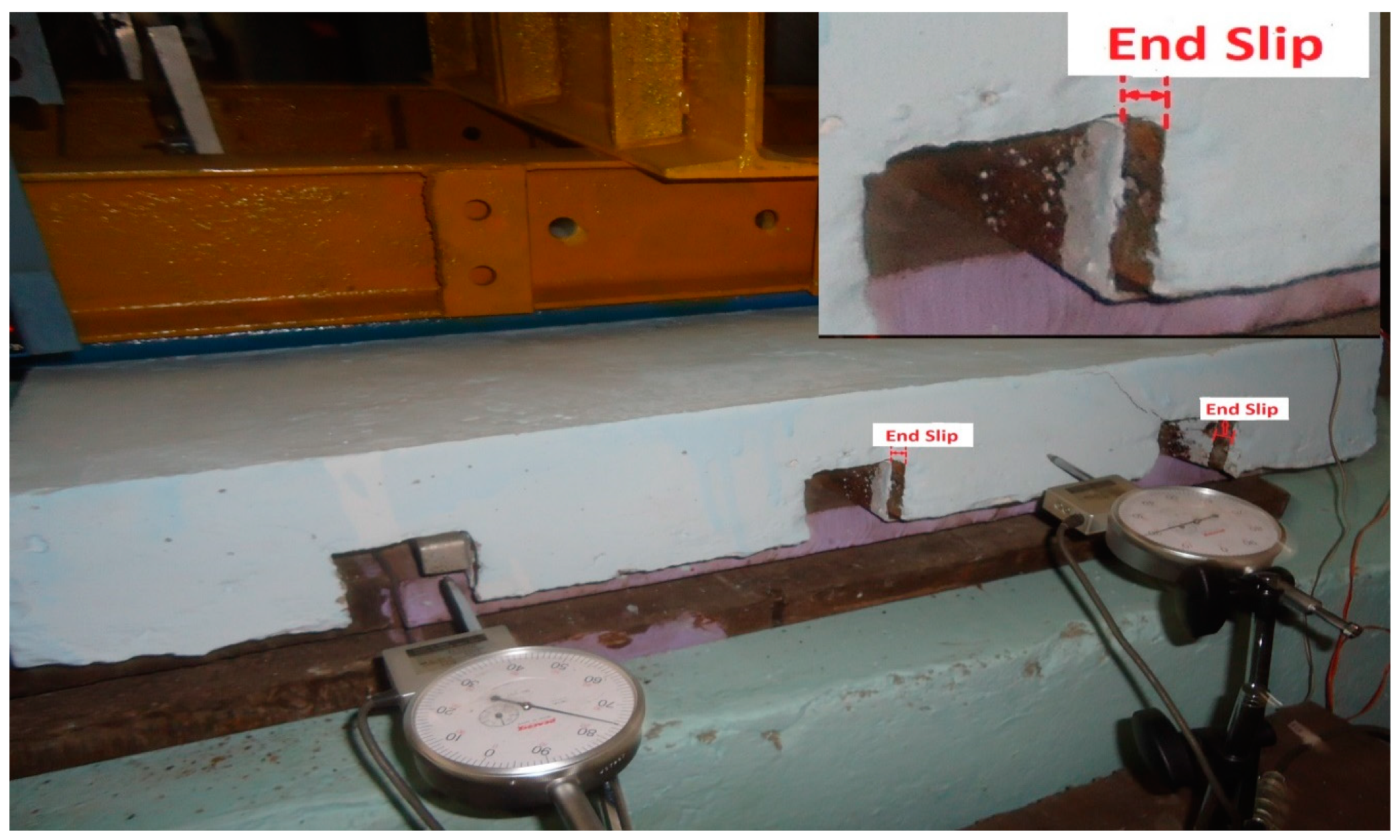
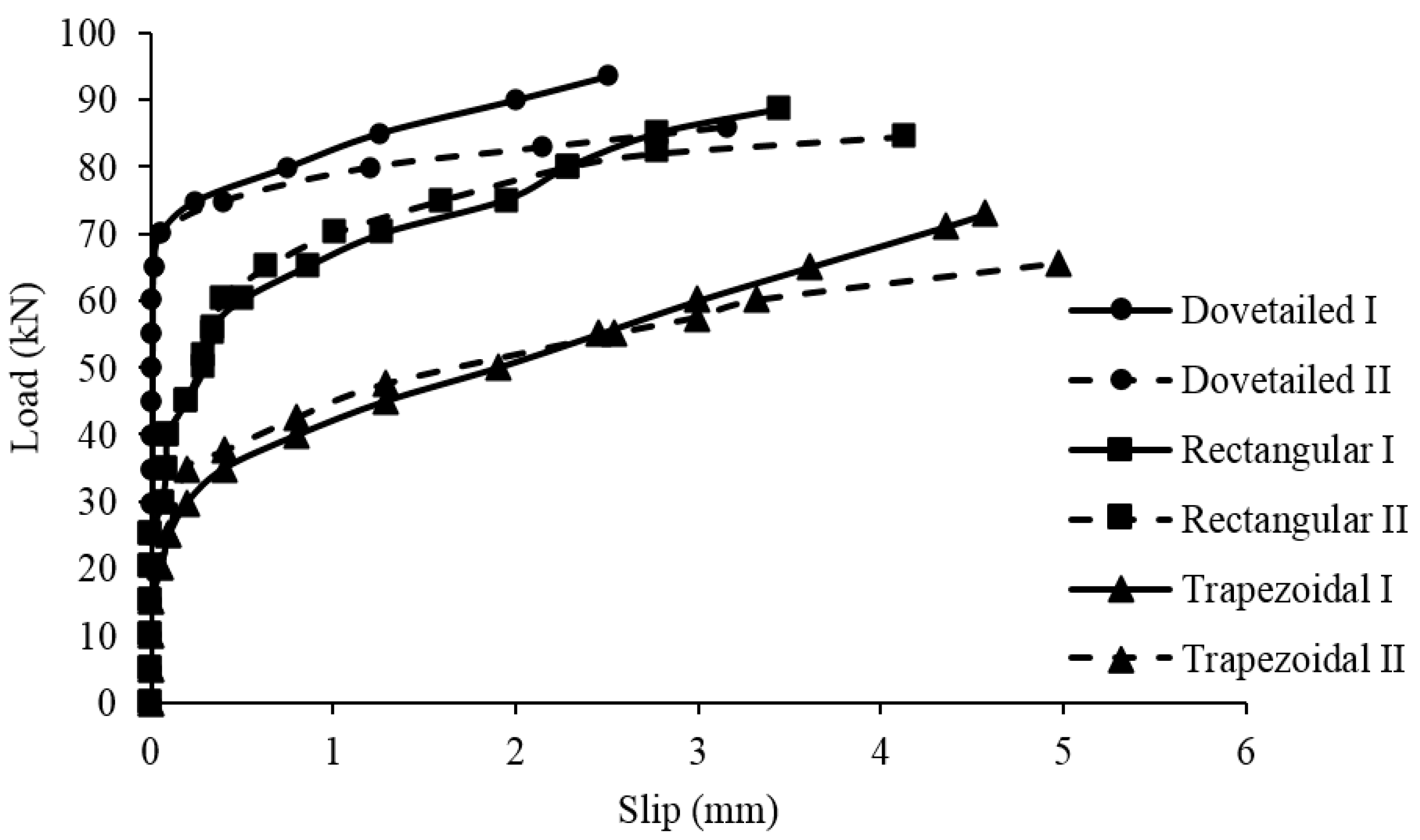
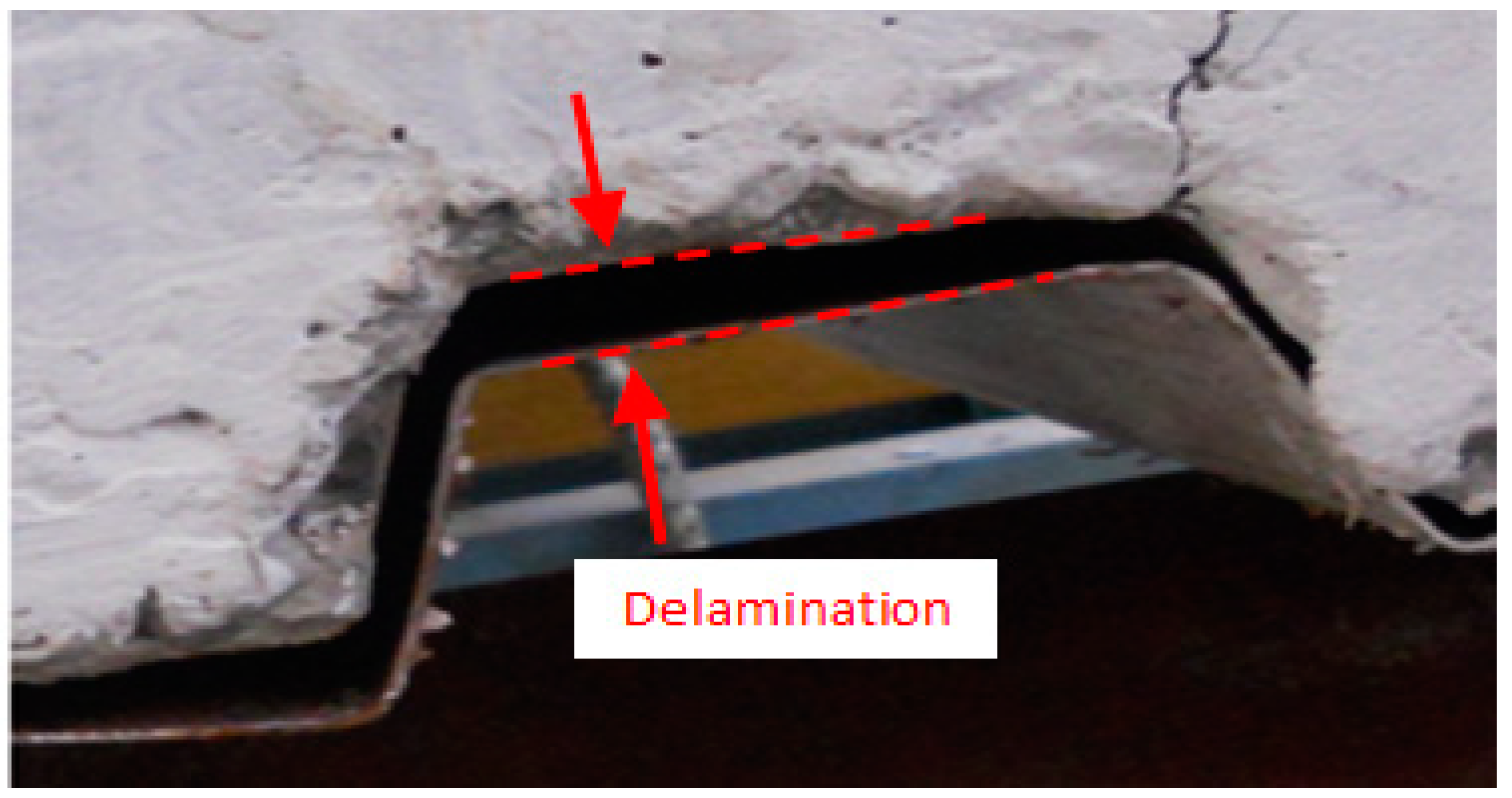
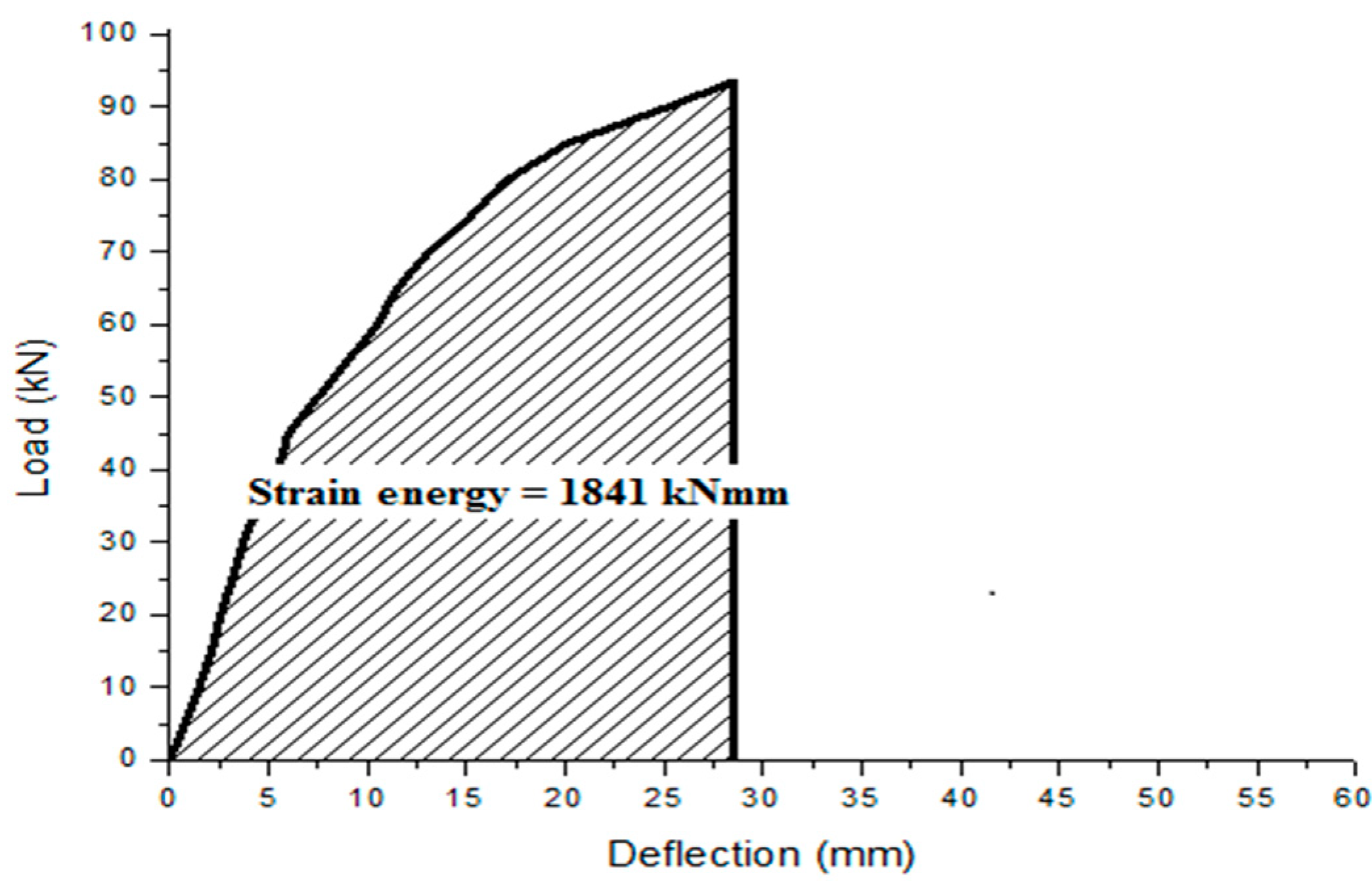
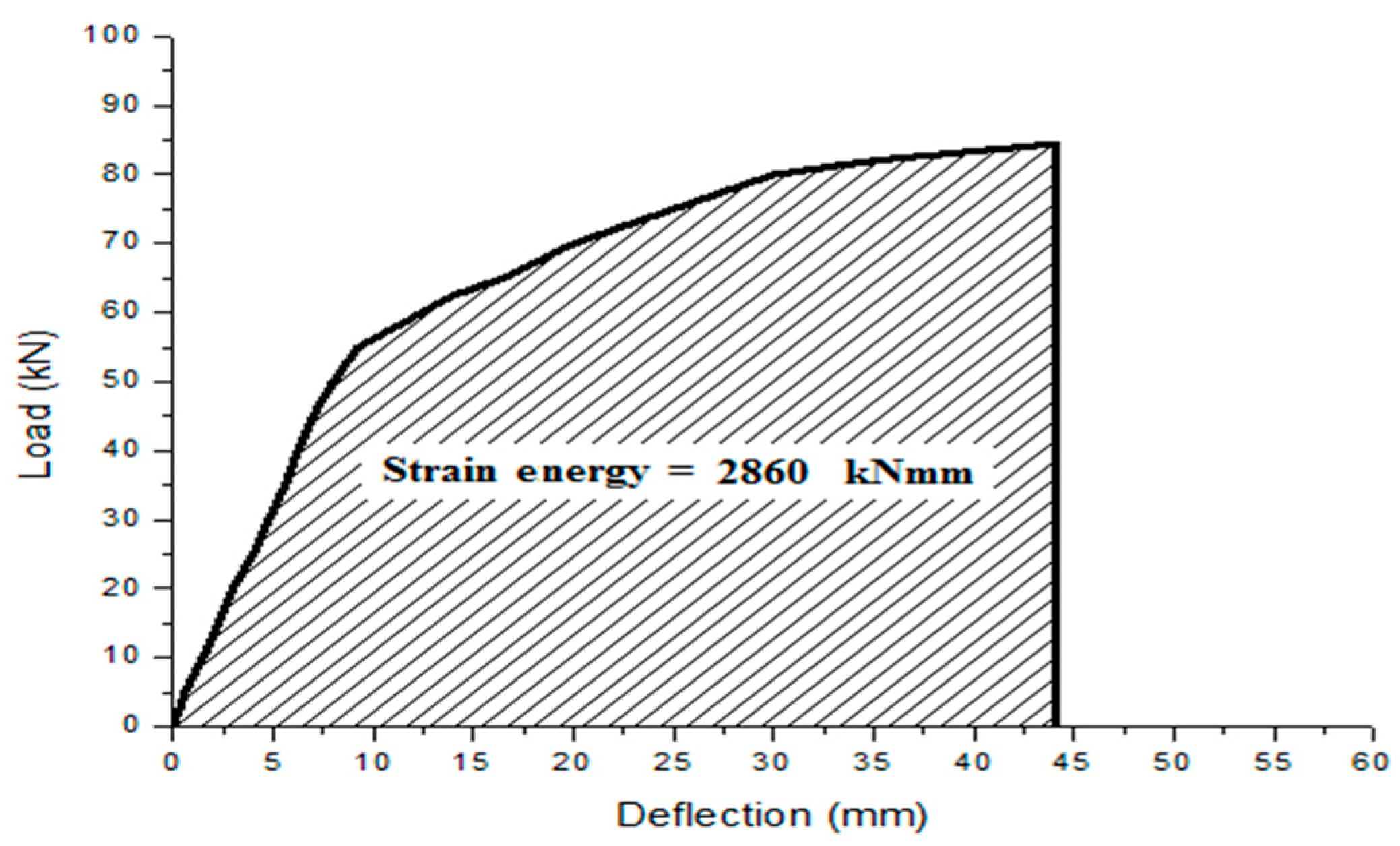
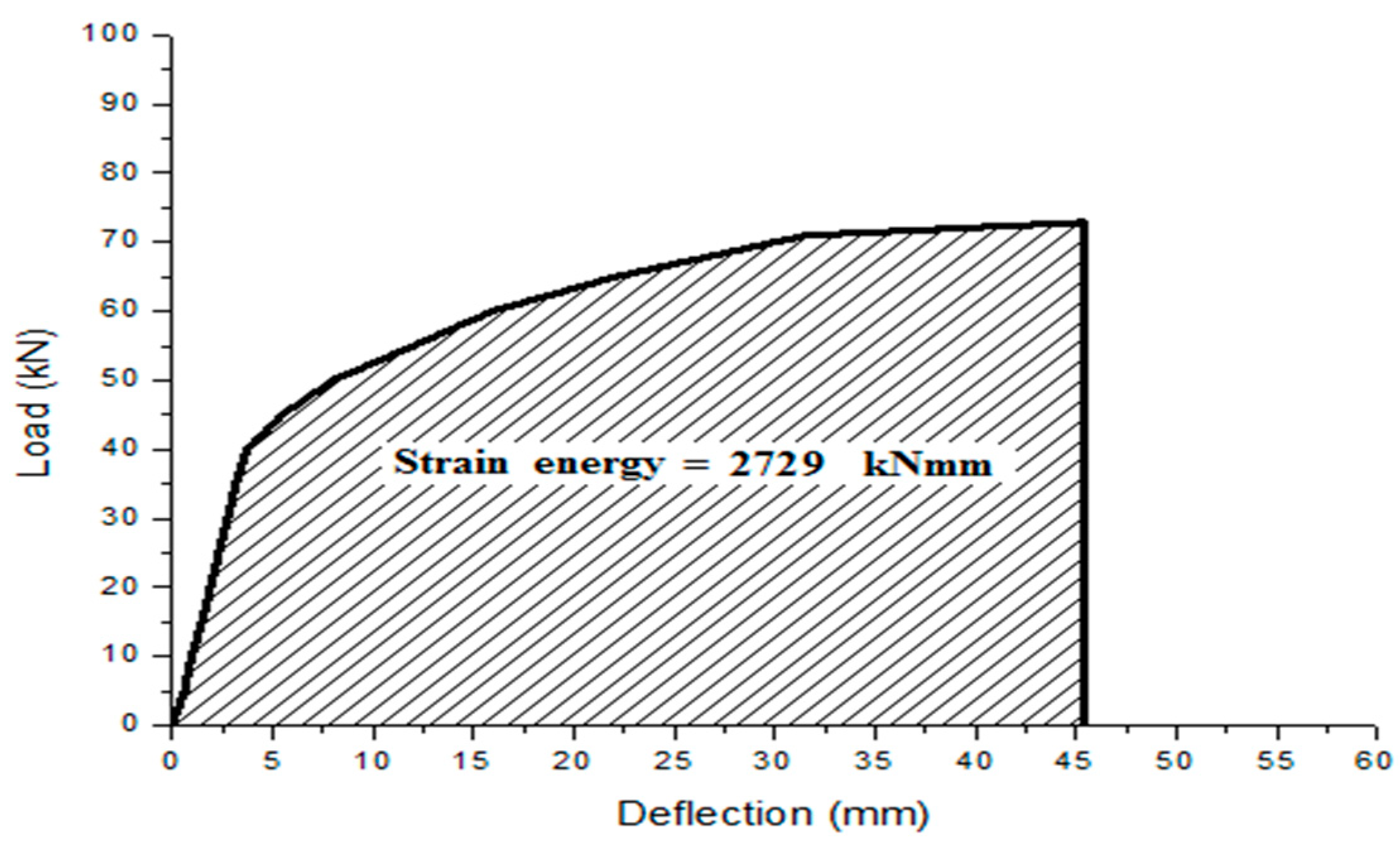
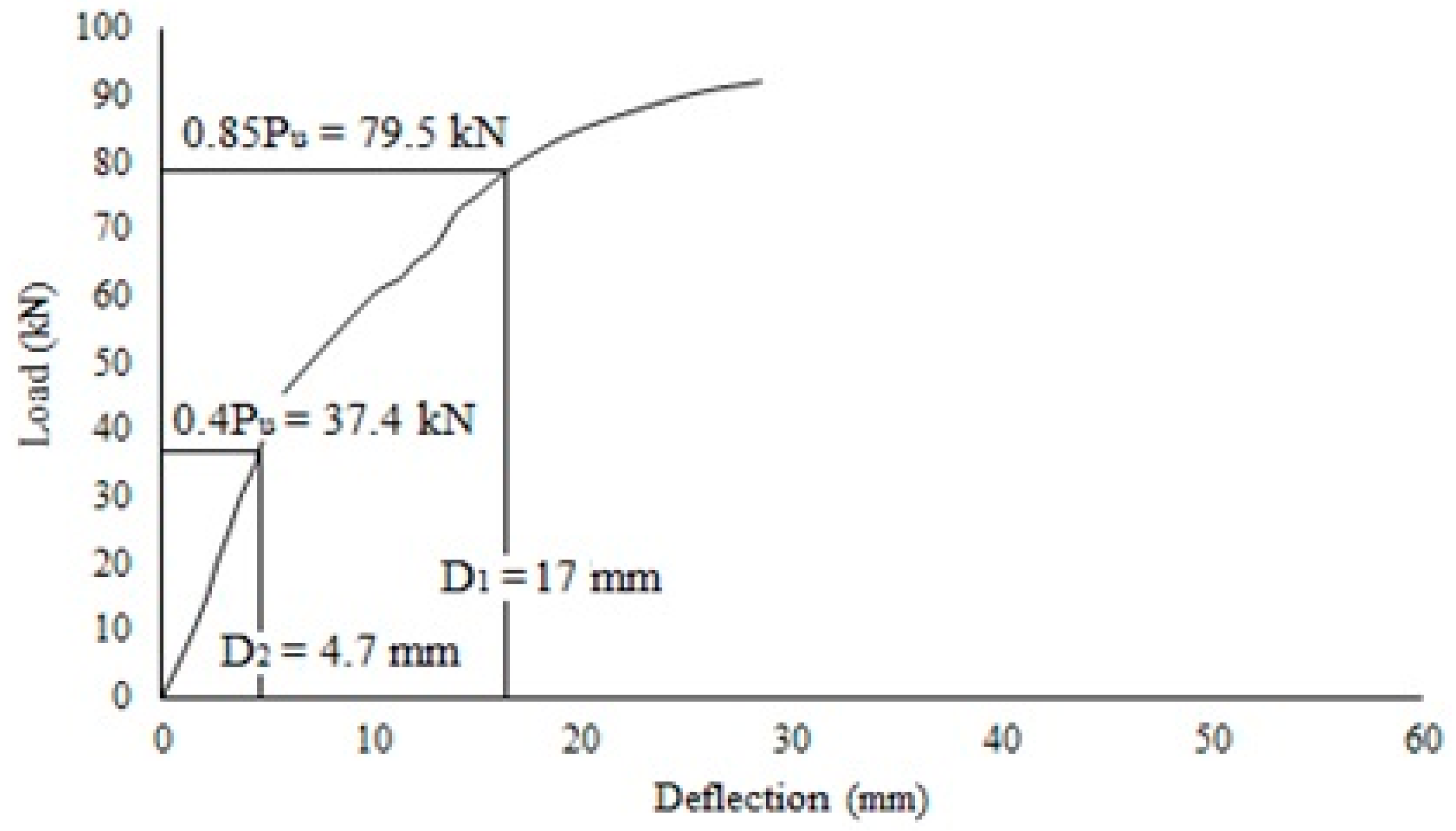
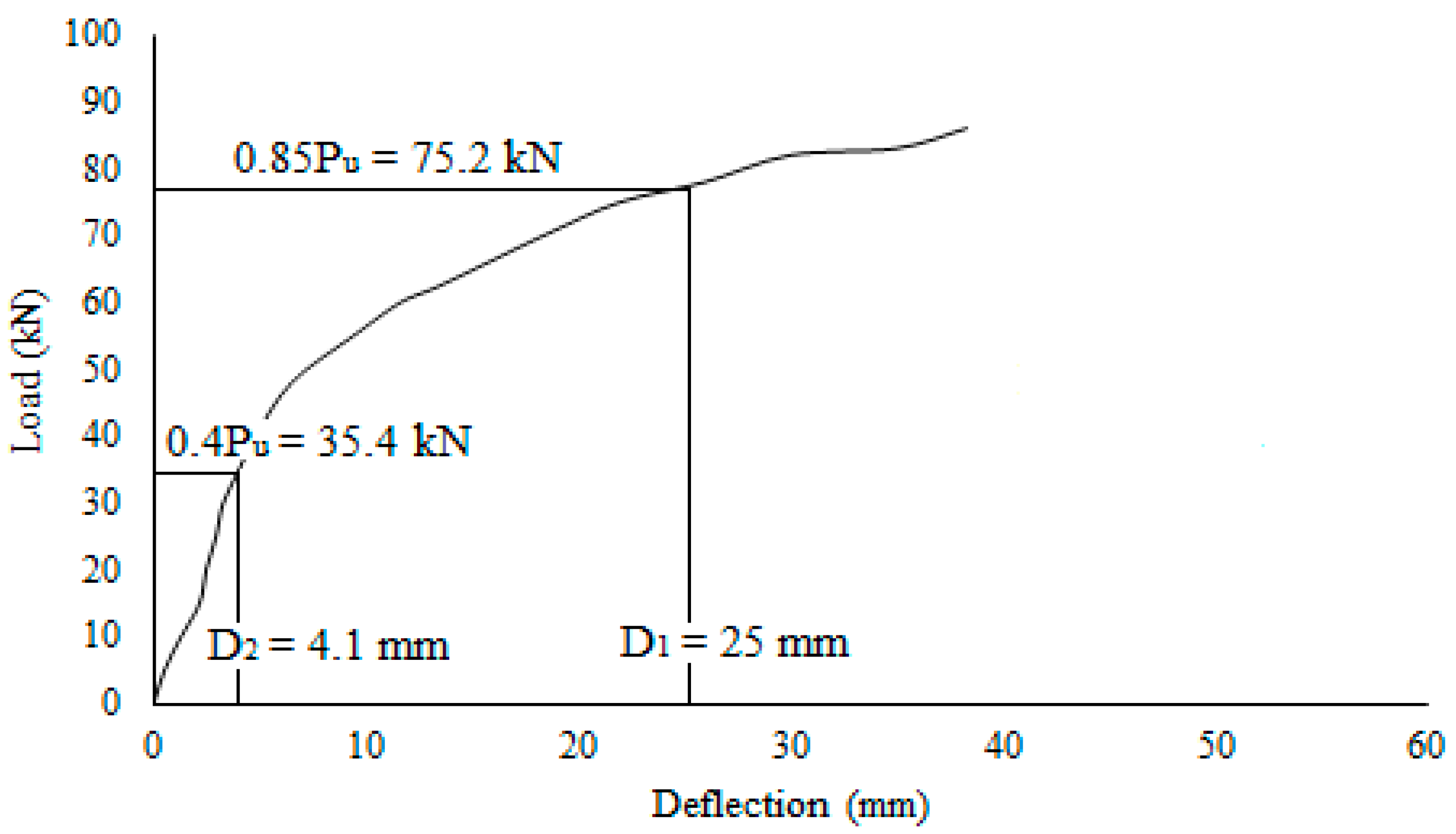
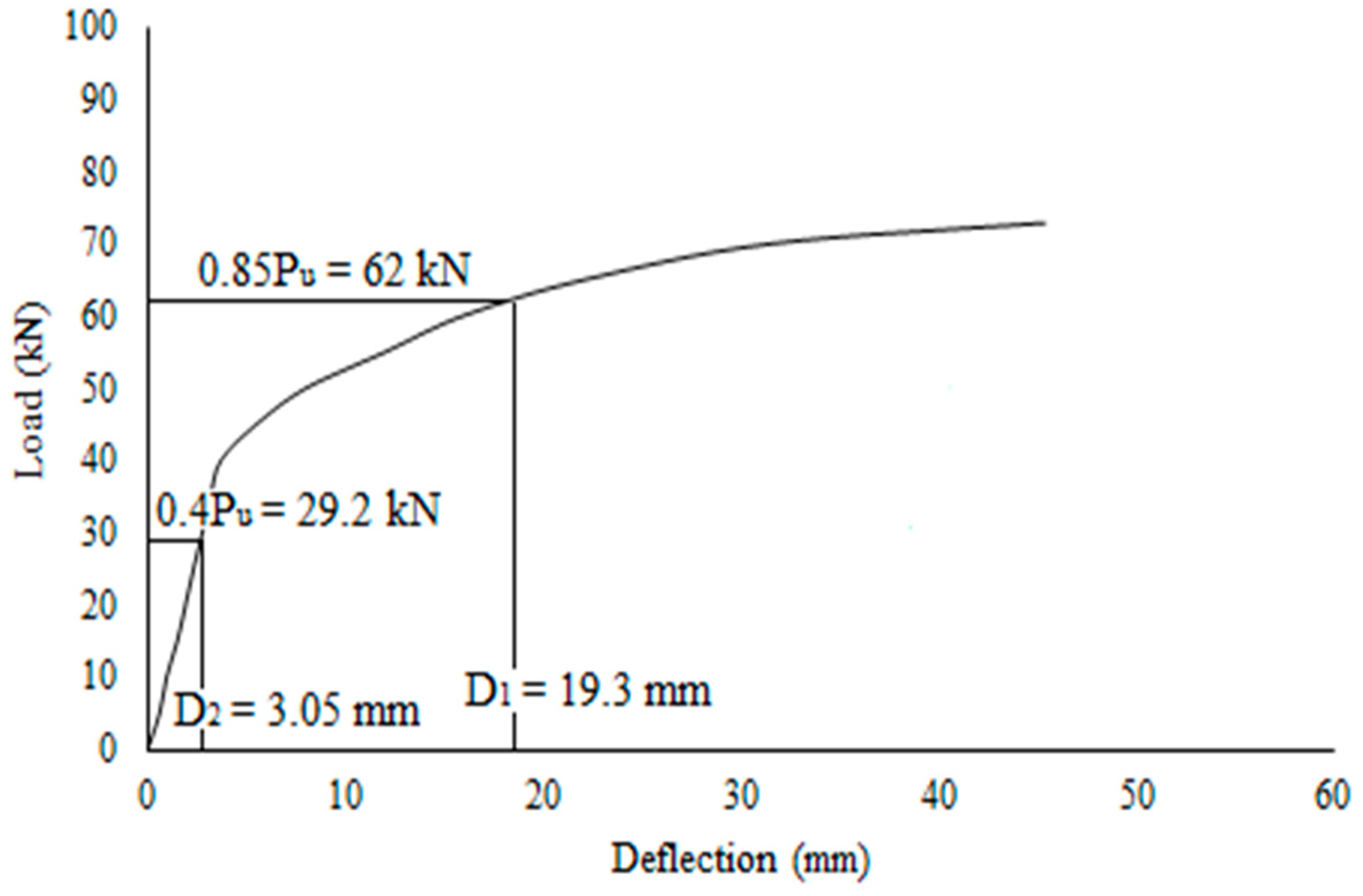
| Property | Value |
|---|---|
| Grade of concrete | M25 |
| Grade of cement | OPC 53 |
| Slump | 75 mm |
| Coarse aggregate Size | 20 mm |
| Water/cement ratio | 0.45 |
| Mix ratio | 1:1.537:2.693 |
| Compressive strength | 33.48 MPa |
| Specimen ID | Asb (mm2) | Yield Strength, fy (MPa) | Yield Strain, εy (μmm/mm) | Ultimate Strength, fu (MPa) | Elongation, εu (%) |
|---|---|---|---|---|---|
| Ø8 | 52.6 | 459.0 | 2300 | 578.4 | 18.0 |
| S | 750 | 266.12 | 1520 | 324.79 | 27.4 |
| Specimen Type | Area (mm2) | Perimeter (mm) | Moment of Inertia (1 × 106 mm4) | Radius of Gyration (mm) | ||
|---|---|---|---|---|---|---|
| Ix | Iy | Rx | Ry | |||
| Dovetailed | 1224.87 | 2451.74 | 0.6 | 222.36 | 22.11 | 426.1 |
| Rectangular | 1048 | 2098 | 0.57 | 195.8 | 23.32 | 432.27 |
| Trapezoidal | 982.6 | 1967.2 | 0.581 | 187.4 | 24.32 | 436.7 |
| S.No | Profiled Steel Sheet | Initial Crack Load (kN) | Ultimate Load (kN) | Deflection (mm) | Slip (mm) |
|---|---|---|---|---|---|
| 1 | Dovetailed slab I | 55 | 93.5 | 28.53 | 2.5 |
| 2 | Dovetailed slab II | 53.2 | 86 | 32.5 | 3.15 |
| 3 | Rectangular slab I | 45 | 88.5 | 38.3 | 3.44 |
| 4 | Rectangular slab II | 46.7 | 84.5 | 44.12 | 4.13 |
| 5 | Trapezoidal slab I | 45 | 72.9 | 45.4 | 4.57 |
| 6 | Trapezoidal slab II | 44 | 65.5 | 52.5 | 4.97 |
| Specimen Detail | Strain Energy (kNmm) | Ductility Ratio (D1/D2) |
|---|---|---|
| Dovetailed profiled—Trial I | 1841 | 3.62 |
| Dovetailed profiled—Trial II | 2078 | 2.85 |
| Rectangle profiled—Trial I | 2860 | 6.1 |
| Rectangle profiled—Trial II | 2371.32 | 4.03 |
| Trapezoidal profiled—Trial I | 2729 | 6.33 |
| Trapezoidal profiled—Trial II | 2987.1 | 9.14 |
Publisher’s Note: MDPI stays neutral with regard to jurisdictional claims in published maps and institutional affiliations. |
© 2021 by the authors. Licensee MDPI, Basel, Switzerland. This article is an open access article distributed under the terms and conditions of the Creative Commons Attribution (CC BY) license (http://creativecommons.org/licenses/by/4.0/).
Share and Cite
Avudaiappan, S.; Saavedra Flores, E.I.; Araya-Letelier, G.; Jonathan Thomas, W.; N. Raman, S.; Murali, G.; Amran, M.; Karelina, M.; Fediuk, R.; Vatin, N. Experimental Investigation on Composite Deck Slab Made of Cold-Formed Profiled Steel Sheeting. Metals 2021, 11, 229. https://doi.org/10.3390/met11020229
Avudaiappan S, Saavedra Flores EI, Araya-Letelier G, Jonathan Thomas W, N. Raman S, Murali G, Amran M, Karelina M, Fediuk R, Vatin N. Experimental Investigation on Composite Deck Slab Made of Cold-Formed Profiled Steel Sheeting. Metals. 2021; 11(2):229. https://doi.org/10.3390/met11020229
Chicago/Turabian StyleAvudaiappan, Siva, Erick I. Saavedra Flores, Gerardo Araya-Letelier, Walter Jonathan Thomas, Sudharshan N. Raman, Gunasekaran Murali, Mugahed Amran, Maria Karelina, Roman Fediuk, and Nikolai Vatin. 2021. "Experimental Investigation on Composite Deck Slab Made of Cold-Formed Profiled Steel Sheeting" Metals 11, no. 2: 229. https://doi.org/10.3390/met11020229
APA StyleAvudaiappan, S., Saavedra Flores, E. I., Araya-Letelier, G., Jonathan Thomas, W., N. Raman, S., Murali, G., Amran, M., Karelina, M., Fediuk, R., & Vatin, N. (2021). Experimental Investigation on Composite Deck Slab Made of Cold-Formed Profiled Steel Sheeting. Metals, 11(2), 229. https://doi.org/10.3390/met11020229












